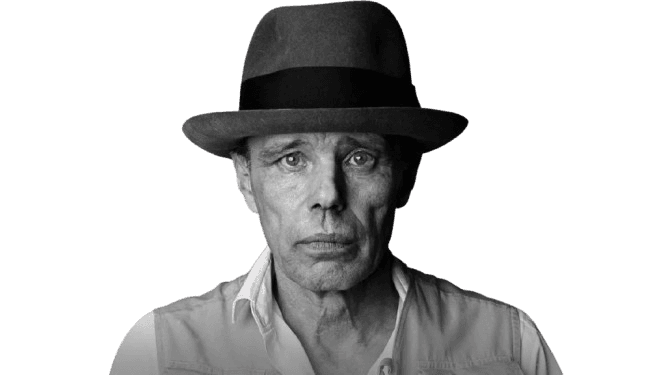Life and achievements
Early life
Joseph Beuys was born on the 12th of May 1921 in Krefeld, Germany, but grew up in Kleve's industrial town. His childhood years were defined by an interest in natural sciences, mythology, and art. Beuys was an outstanding student, good at drawing and music, and a pianist and cellist. However, his adolescence was not very happy during the period when the Nazi party was on the rise in Germany; he had to join the Hitler Youth – a movement that every young German had to join.
World War II marked Beuys: he was a young boy during the war, but the horrors that took place influenced his work. He volunteered at the Luftwaffe and worked as a radio operator. During the Second World War, he was a member of a Kriegsmarine unit, and his plane crashed in Crimea in 1944. Beuys said that he was saved by nomadic Tatars who covered his wounds with fat and felt. Although this story has been discussed widely, it became a myth in the author's life and art, reflecting his conceptions of rebirth, survival, and transformation.
As a result of the war, Beuys lost his enthusiasm for medicine and switched to art, though he joined the Kunstakademie Düsseldorf in 1946. Studying under the sculptor Ewald Mataré had a significant impact on him, especially Mataré’s concentration on the spiritual and the natural in artworks. In the early 1950s, Beuys started using materials such as fat, felt, and beeswax as a medium for his works.
Legacy
Joseph Beuys was an artist who believed in change-making that affected people and their art in society. He was one of the founders of the movement of performance, and in many cases, was the division made between reality and theatre by his shocking actions. Another of Beuys’s most popular concepts still actively used in contemporary art is that of social sculpture, the notion that every person is capable of creativity and, through this creativity, can change society.
Beuys was also a political activist whose primary concern was environmentalism and democracy. His participation in the creation of the German Green Party and his work with movements for ecological responsibility emphasized his view of the artist as a director of the future. His 7,000 Oaks project is still considered a symbol of his activism for environmental issues, the participation of people in society, and the role of art in reclaiming the landscape.
Nevertheless, Beuys’s critics accused him of self-creating myths. However, his impact on contemporary art is indisputable. His work expanded the horizons of materials and techniques in art, starting with sculpture and ending with performance and installation. The last effect of Beuys’s pedagogical practice is that his ideas about democratizing creativity influenced art education for many years.
Milestone moments
Mar 25, 1944
Plane Crash in Crimea
Joseph Beuys’s life was altered when he was shot down over Crimea in March of 1944 in a German plane.
In an interview, Beuys recalled how he was saved by the nomadic Tatars who put him to felt and fat so that he could heal.
However, as this story entered the status of a myth in his life, it was a sign of the main topics in his work, including healing, survival, and change.
This experience became part of Beuys’s persona and inspired his use of felt and fat in his later creations.
Nov 25, 1965
How to Explain Pictures to a Dead Hare
How to Explain Pictures to a Dead Hare was first shown at the Galerie Schmela in Düsseldorf in 1965.
The performance consisted of Beuys describing artworks to a dead hare while covering his head with honey and gold foil.
This action reflected Beuys's statements about the mystery and complexity of art and the impossibility of communication and comprehension.
It turned into one of his most famous performances, showing the audience his way of how life, art, and philosophy can intertwine.
Oct 16, 1972
Dismissal from Kunstakademie Düsseldorf
In 1972, Beuys was dismissed from teaching at the Kunstakademie Düsseldorf due to political controversy regarding the admission policy.
Beuys had enrolled more than one hundred students who had been turned down by the academy and demanded that art education be available to anyone.
This act proved that Beuys would fight for the right to an equal education and that creativity was a right for everyone.
His dismissal only made him a popular figure as a radical thinker and reformist in the education sector for future generations of educators.
Oct 23, 1982
Documenta 7: 7,000 Oaks
7,000 Oaks is still one of Beuys’s most essential pieces; it was installed at Documenta 7 in Kassel, Germany, in 1982.
For Beuys, art was a tool for ecological and social change, and he buried 7,000 oak trees, each with a basalt stone.
This project indeed embodied what Beuys called social sculpture, which meant that art can construct the world around us.
The project remains relevant today as a symbol and a great example of environmentalism and artivism.
